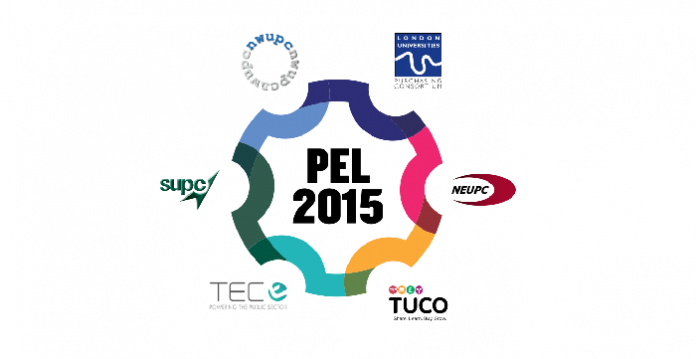In an already crowded HE sector, can another sector body, Procurement England Limited (PEL), really add value? In an interview, Rex Knight, chair of the PEL Board, says yes and explains how.
Q: Can you tell us a bit about PEL?
Rex Knight (RK): For those unfamiliar with this new member of the HE sector, PEL is a partnership between six higher education (HE) purchasing consortia in England, and acts as a vehicle to advance collaborative procurement within the HE sector. Rather than operating as a separate body, PEL provides a formalised way for the consortia to work together for the benefit of their members and the sector as a whole.
PEL does not have any dedicated employees, and relies on joint funding from all of its consortia members – London Universities Purchasing Consortium (LUPC), the North Eastern Universities Purchasing Consortium (NEUPC), the North Western Universities Purchasing Consortium (NWUPC), the Southern Universities Purchasing Consortium (SUPC), The Energy Consortium (TEC) and The University Caterers Organisation (TUCO).
Q: What prompted the creation of PEL?
RK: Procurement is clearly going to be of increasing importance for universities as they invest in equipment, capital and services to deliver an excellent student experience, outstanding research and all of the other aspects of their mission. We are all, of course, doing that in the context of value for money.
While cost must be a focus, it is not the only priority – the quality of what we purchase is also critical. The regional purchasing consortia have been, and continue to be, very successful, but there is recognition that we could add greater value to the sector by having a body to bring the consortia together into more formal collaboration. There is also a strong sense that we were not getting out the good news about how effective we are in procurement, and that PEL could help with that.
Q: And what has PEL achieved so far?
RK: Well, it’s early days! We now have a plan for PEL, which we believe will deliver benefits to the sector but the proof of the pudding is in the eating, so perhaps it’s best to ask that question again towards the end of the year.
Q: What does PEL hope to achieve over the next year? What about in the long term?
RK: PEL has six key strategic aims that will guide our objectives over the next year and throughout the longer term. These aims cover things like negotiating more collaborative supply agreements, moving from contract to category management, and making our supply agreements easier to use.
We are also looking to collaborate with procurement organisations in the wider public sector, and set-up a formalised way of measuring and reporting savings and benefits back to HE sector members. I would encourage interested members of the HE community to take a look at the PEL Implementation Plan to learn more.
The current plan has some actions for the next few months to demonstrate that we can work together through PEL. It will then be important to stand back and think about the longer term in light of experience.
Q: How will PEL impact consortia and how they operate?
RK: The consortia already work closely together so I don’t think PEL will have a dramatic impact; it’s evolutionary rather than revolutionary. It has no funding and no staff so it can only work by collaboration between the chairs and chief executives on behalf of consortia members.
Q: How will PEL build on the work already being done by consortia?
RK: PEL will only succeed by working with and through the consortia, and building on the history of collaboration between them. The consortia have already been working together through a joint contracting group and currently share data and systems.
Q: What practical things will PEL deliver to consortia members?
RK: Our action plan includes several tangible deliverables that will provide practical benefits to the sector; for example, in 2015 we will be undertaking category analysis. This analysis will support the development of a national contracting plan that will simplify the agreement landscape ensuring agreements offered provide value for money and meet member needs.
We are also looking to support the adoption of category management. Category management will ensure a methodical approach to markets and supplier management, in-depth knowledge of products and industry forces by contract managers, and the development of relevant strategies and agreements to best meet needs.
Q: What do you see as PEL’s biggest challenge?
RK: The sector is complex and diverse so meeting the needs of institutions is a challenge for PEL just as it is for the consortia. Also as for the consortia, it makes engagement a real challenge, and of course, we are only really going to make progress on procurement if practice in institutions moves forward to the standards of the best, as well as in the consortia and PEL. I think the next few months will also test how realistic it is to expect PEL to operate effectively as a virtual organisation with no resources of its own.
Q: Do I have a say in PEL? How do I get involved within my institution?
RK: The chair person of each of the consortia boards also sits on the PEL Board, and so will be feeding in the views of their consortium and their own board’s priorities. I would be more than happy to hear from colleagues in institutions if they have suggestions and comments on the work of PEL.
PEL will continue to support and promote collaborative procurement within the HE sector over the months ahead, and we’re looking forward to delivering on our commitments.
For further information on PEL or to feedback on PEL’s activities, please contact your head of consortia or Rex Knight at rex.knight@ucl.ac.uk.
Rex Knight is vice-provost (operations) at University College London








